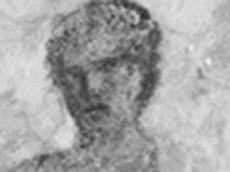|
|
TODAY.AZ / Weird / Interesting
Airport body scanner detects ancient Roman fresco
16 April 2013 [13:09] - TODAY.AZ
 Airport scanners can see more than your underwear. Terahertz spectroscopy, the imaging technology used in airport body scanners, has uncovered a hidden, ancient fresco underneath a wall painting at the Louvre.
Airport scanners can see more than your underwear. Terahertz spectroscopy, the imaging technology used in airport body scanners, has uncovered a hidden, ancient fresco underneath a wall painting at the Louvre.Terahertz spectroscopy uses beams of electromagnetic radiation that lie between microwaves (used in kitchen ovens) and infrared rays (used in TV remotes) on the spectrum. These waves are known for their ability to examine materials without damaging them, unlike X-rays and ultraviolet light, and are commonly used in other areas like biomedical imaging and pharmaceuticals.
While using this technology to examine a painting, Bianca Jackson, a postdoctoral research fellow at the University of Rochester, found evidence of another painting underneath.
“We were amazed, and we were delighted,” she said during a presentation to the American Chemical Society. “We could not believe our eyes as the image materialized on the screen. Underneath the top painting of the folds of a man’s tunic, we saw an eye, a nose and then a mouth appear. We were seeing what likely was part of an ancient Roman fresco, thousands of years old.”
The ‘he” referred to is Giampetro Campana, a 19th century Italian art collector who assembled an impressive collection of Greek, Roman, and early Italian artwork. Back then, it was common practice for artists to paint over existing works of art, either because they could not afford new canvases or because patrons commissioned new artwork to cover up older or unsuccessful pieces. Researchers had reason to believe that Campana commissioned Trois hommes armes de lances to go over another image.
Initially, the team tried using x-ray radiography and x-ray fluorescence to find out what secrets lurked beneath. However, it wasn’t until they tried terahertz spectroscopy that the original artwork peeked through.
“No previous imaging technique, including almost half a dozen commonly used to detect hidden images below paintings, forged signatures of artists and other information not visible on the surface, has revealed a lost image in this fresco,” Jackson said. “This opens the door to wider use of the technology in the world of art, and we also used the method to study a Russian religious icon and the walls of a mud hut in one of humanity’s first settlements in what was ancient Turkey.”
/The Washington Post/
URL: http://www.today.az/news/interesting/121461.html
 Print version
Print version
Views: 1619
Connect with us. Get latest news and updates.
See Also
- 19 February 2025 [22:20]
Visa and Mastercard can return to Russia, but with restrictions - 05 February 2025 [19:41]
Japan plans to negotiate with Trump to increase LNG imports from United States - 23 January 2025 [23:20]
Dubai once again named cleanest city in the world - 06 December 2024 [22:20]
Are scented candles harmful to health? - 23 November 2024 [14:11]
Magnitude 4.5 earthquake hits Azerbaijan's Lachin - 20 November 2024 [23:30]
Launch vehicle with prototype of Starship made its sixth test flight - 27 October 2024 [09:00]
Fuel prices expected to rise in Sweden - 24 October 2024 [19:14]
Turkiye strikes terror targets in Iraq and Syria - 23 October 2024 [23:46]
Kazakhstan supplied almost entire volume of oil planned for 2024 to Germany in 9 months - 23 October 2024 [22:17]
Taiwan reported passage of Chinese Navy aircraft carrier near island
Most Popular
 Azerbaijan, Israel hold fourth joint commission meeting in Jerusalem
Azerbaijan, Israel hold fourth joint commission meeting in Jerusalem
 Victim testimonies heard as trial of Ruben Vardanyan continues in Baku Military Court
Victim testimonies heard as trial of Ruben Vardanyan continues in Baku Military Court
 Baku hosts second day of International Banking Forum
Baku hosts second day of International Banking Forum
 Turkiye expands its African sphere of influence with bold Libya shift
Turkiye expands its African sphere of influence with bold Libya shift
 AzInTelecom participates as key partner at 9th International Banking Forum
AzInTelecom participates as key partner at 9th International Banking Forum
 IFC marks 30 years of support for Azerbaijan’s economic development
IFC marks 30 years of support for Azerbaijan’s economic development
 To whom is Khachaturian showing the Kremlin?
To whom is Khachaturian showing the Kremlin?
